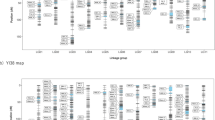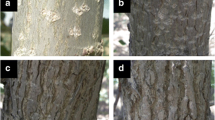Abstract
The present study aimed to dissect tree architectural plasticity into genetic, ontogenetic and environmental effects over the first 4 years of growth of an apple F1 progeny by means of quantitative traits loci (QTL) mapping. Both growth and branching processes were phenotyped on the consecutive annual shoots of different axes within a tree. For each studied trait, predicted values (best linear unbiased predictors, BLUPs) of the genotypic (G) effect or its interaction with tree age (G×A) and climatic year (G×Y) were extracted from mixed linear models of repeated data. These BLUPs, which are independent from autocorrelations between repeated measurements, were used for QTL mapping. QTL detection power was improved by this two-step approach. For each architectural process, numerous QTLs were detected and some particularly interesting co-localised in common genomic regions, for internode lengthening, top diameter, and number and percentage of axillary shoots. When several QTLs were detected for a given trait, global models were estimated, which explained a maximum of 40% of the total variance for both internode length and top diameter and 28% for branching. QTLs detected for BLUPs of G×Y effects were interpreted as resulting from the interaction between genetic maximal potential of growth and climatic factors, while those for G×A effects were interpreted in relation to tree ontogeny. Most of the latter ones were found to be concomitant with key development stages during which the trait average started to decrease, but with different magnitudes depending on genotype.




Similar content being viewed by others
References
Allen MT, Prusinkiewicz P, DeJong TM (2005) Using L-systems for modeling source–sink interactions, architecture and physiology of growing trees: the L-PEACH model. New Phytol 166:869–880
Alméras T, Gril J, Costes E (2002) Bending of apricot tree branches under the weight of axillary growth: test of a mechanical model with experimental data. Trees 16:5–15
Barthélémy D, Caraglio Y, Costes E (1997) Architecture, gradients morphogénétiques et âge physiologique chez les végétaux. In: Bouchon J, Reffye de P, Barthelemy D (eds) Modélisation et simulation de l’architecture des végétaux, INRA éditions, Paris, pp 89–136
Bradshaw-Jr HD, Stettler RF (1995) Molecular genetics of growth and development in Populus. IV. Mapping QTLs with large effects on growth, form, and phenology traits in a forest tree. Genetics 139:963–973
Churchill GA, Doerge RW (1994) Empirical threshold values for quantitative trait mapping. Genetics 138:963–971
Conner PJ, Brown SK, Weeden NF (1997) Randomly amplified polymorphic DNA-based genetic linkage maps of three apple cultivars. J Am Soc Hortic Sci 122:350–359
Conner PJ, Brown SK, Weeden NF (1998) Molecular-marker analysis of quantitative traits for growth and development in juvenile apple trees. Theor Appl Genet 96:1027–1035
Costes E, Sinoquet H, Kelner JJ, Godin C (2003) Exploring within-tree architectural development of two apple tree cultivars over 6 years. Ann Bot (Lond) 91:91–104
Durand JB, Guédon Y, Caraglio Y, Costes E (2005) Analysis of the plant architecture via tree-structured statistical models: the hidden Markov tree models. New Phytol 166:813–825
Génard M, Pagès L, Kervella J (1994) Relationship between sylleptic branching and components of parent shoot development in the peach tree. Ann Bot (Lond) 74:465–470
Hallé F, Oldman RA, Tomlinson PB (1978) Tropical trees and forests: an architectural analysis. Springer, Berlin
Hemmat M, Weeden NF, Brown SK (2003) Mapping and evaluation of Malus x domestica microsatellites in apple and pear. J Am Soc Hort Sci 128:515–520
Jansen RC, Stam P (1994) High resolution of quantitative traits into multiple loci via interval mapping. Genetics 136:1447–1455
Jiang C, Zeng ZB (1995) Multiple trait analysis of genetic mapping for quantitative trait loci. Genetics 140:1111–1127
Kenis K, Keulemans J (2005) Genetic linkage maps of two apple cultivars (Malus x domestica Borkh.) based on AFLP and microsatellite markers. Mol Breed 15:205–219
Kenis K, Keulemans J (2007) Study of tree architecture of apple (Malus x domestica Borkh.) by QTL analysis of growth traits. Mol Breed 19:193–208
Korol AB, Ronin YI, Kirzhner VM (1995) Interval mapping of quantitative trait loci employing correlated trait complexes. Genetics 140:1137–1147
Lauri PE, Térouanne E, Lespinasse JM, Regnard JL, Kelner JJ (1995) Genotypic differences in the axillary bud growth and fruiting pattern of apple fruiting branches over several years—an approach to regulation of fruit bearing. Sci Hortic 64:264–281
Liebhard R, Kellerhals M, Pfammatter W, Jertmini M, Gessler C (2003) Mapping quantitative physiological traits in apple (Malus x domestica Borkh.). Plant Mol Biol 52:511–526
Littell RC, Pendergast J, Natarajan R (2000) Modelling covariance structure in the analysis of repeated measures data. Stat Med 19:1793–1819
Loughin TM (2006) Improved experimental design and analysis for long-term experiments. Crop Sci 46:2492–2502
Ma CX, Casella G, Wu RL (2002) Functional mapping of quantitative trait loci underlying the character process: a theoretical framework. Genetics 161:1751–1762
Ma CX, Lin M, Littell RC, Yin T, Wu R (2004) A likelihood approach for mapping growth trajectories using dominant markers in a phase-unknown full-sib family. Theor Appl Genet 108:699–705
Maliepaard C, Alston F, van Arkel G, Brown LM, Chevreau E, Dunemann F, Evans KM, Gardiner S, Guilford P, van Heusden AW, Janse J, Laurens F, Lynn JR, Manganaris AG, den Nijs APM, Periam N, Rikkerink E, Roche P, Ryder C, Sansavini S, Schmidt H, Tartarini S, Verhaegh JJ, Vrielink-van Ginkel M, King GJ (1998) Aligning male and female linkage maps of apple (Malus pumila Mill.) using multi-allelic markers. Theor Appl Genet 97:60–73
Mangin B, Thoquet P, Grimsley N (1998) Pleiotropic QTL analysis. Biometrics 54:88–99
Niklas KJ (1994) Comparisons among biomass allocation and spatial distribution patterns of some vine, pteridophyte, and gymnosperm shoots. Am J Bot 81:1416–1421
Plomion C, Durel CE, O’Malley DM (1996) Genetic dissection of height in maritime pine seedlings raised under accelerated growth conditions. Theor Appl Genet 93:849–858
Powell GR (1987) Syllepsis in Larixlaricina: analysis of tree leaders with and without sylleptic long shoots. Can J For Res 17:490–498
Renton M, Guédon Y, Godin C, Costes E (2006) Similarities and gradients in growth unit branching patterns during ontogeny in ‘Fuji’ apple trees: a stochastic approach. J Exp Bot 57:3131–3143
SAS Institute Inc (2000) SAS user’s guide: Statistics. SAS Institute, Cary, NC
Scotti-Saintagne C, Bodénès C, Barreneche T, Bertocchi E, Plomion C, Kremer A (2004) Detection of quantitative trait loci controlling bud burst and height growth in Quercus robur L. Theor Appl Genet 109:1648–1659
Segura V, Denancé C, Durel CE, Costes E (2007) Wide range QTL analysis for complex architectural traits in a 1-year-old apple progeny. Genome 50:159–171
Segura V, Cilas C, Costes E (2008) Dissecting apple tree architecture into genetic, ontogenetic and environmental factors: mixed linear modelling of repeated spatial and temporal measures. New Phytol 178:302–314
Silfverberg-Dilworth E, Matasci CL, Van de Weg WE, Van Kaauwen MPW, Walser M, Kodde LP, Soglio V, Gianfranceschi L, Durel CE, Costa F, Yamamoto T, Koller B, Gessler C, Patocchi A (2006) Microsatellite markers spanning the apple (Malus x domestica Borkh.) genome. Tree Genet Genomes 2:202–224
Stam P, Van Ooijen JW (1995) JoinMap™ version 2.0: software for the calculation of genetic linkage maps. CPRO-DLO, Wageningen
Van Ooijen JW, Boer MP, Jansen RC, Maliepaard C (2002) MAPQTL® 4.0, software for the calculation of QTL positions on genetic maps. Plant Research International, Wageningen
Verhaegen D, Plomion C, Gion J, Poitel M, Costa P, Kremer A (1997) Quantitative trait dissection analysis in eucalyptus using rapd markers: 1. Detection of QTL in interspecific hybrid progeny, stability of QTL expression across different ages. Theor Appl Genet 95:597–608
Voorrips RE (2001) MapChart® version 2.1: Windows software for the graphical presentation of linkage maps and QTLs. Plant Research International, Wageningen
White J (1979) The plant as a metapopulation. Ann Rev Ecol Syst 10:109–145
Wu RL (1998) Genetic mapping of QTLs affecting tree growth and architecture in Populus: implication for ideotype breeding. Theor Appl Genet 96:447–457
Wu RL, Lin M (2006) Functional mapping—how to map and study the genetic architecture of dynamic complex traits. Nat Rev Genet 7:229–237
Wu R, Stettler RF (1996) The genetic resolution of juvenile canopy structure and function in a three-generation pedigree of Populus. Trees 11:99–108
Wu R, Stettler RF (1998) Quantitative genetics of growth and development in Populus. III. Phenotypic plasticity of crown structure and function. Heredity 81:299–310
Wu R, Ma C-X, Lin M, Casella G (2004) A general framework for analyzing the genetic architecture of developmental characteristics. Genetics 166:1541–1551
Acknowledgements
We acknowledge Mark Jones for improving the English. This research was partly funded by a grant from the INRA genetic and plant breeding department and Languedoc-Roussillon region, allocated to Vincent Segura.
Author information
Authors and Affiliations
Corresponding author
Additional information
Communicated by A. Dandekar
Electronic supplementary material
Below is the linked to the electronic supplementary material.
Figure S1
Genomic positions of QTLs detected on the linkage groups of the integrated ‘Starkrimson’ × ‘Granny Smith’ map for primary growth traits on the 123 genotypes replicated twice in the design planted in 2004. These data were analysed using a classic univariate approach without mixed linear modelling of repeated data, i.e. the data collected on the successive AS were analysed separately, and data collected on the different axes within a tree were not gathered to constitute the whole tree scale.QTLs are represented by boxes extended by lines representing the LOD-1 and LOD-2 confidence intervals. Triangle LOD peak. Boxes are coloured according to trait (GIF 68 kb)
Table S1
Correlations between BLUPs of (S1.a.) genotypic and age effects for mean internode length and (S1.b.) genotypic effect for mean internode length and length of the longest internode, and 2006 year effect for top diameter (DOC 108 kb)
Rights and permissions
About this article
Cite this article
Segura, V., Durel, CE. & Costes, E. Dissecting apple tree architecture into genetic, ontogenetic and environmental effects: QTL mapping. Tree Genetics & Genomes 5, 165–179 (2009). https://doi.org/10.1007/s11295-008-0181-x
Received:
Revised:
Accepted:
Published:
Issue Date:
DOI: https://doi.org/10.1007/s11295-008-0181-x




